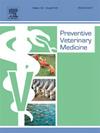Network of ship movements and its potential in spreading pathogenic infectious salmon anemia virus among Norwegian fish farms
IF 2.4
2区 农林科学
Q1 VETERINARY SCIENCES
引用次数: 0
Abstract
In Norway, infectious salmon anemia (ISA) is a notifiable and economically important disease. Accurately understanding between-farm transmission remains essential for ISA control and prevention. Using a network approach, our objective was to assess whether ship movements could potentially contribute to the transmission of pathogenic variants of ISA virus (ISAV-HPRΔ) between farms.
We described yearly static ship contact (reconstructed according to delay between visits: Δ = 1, 8 and 15 days) and company affiliation networks. We assessed the relevance of salmon production areas as subdivisions of these networks. Finally, we identified ship movements that could have resulted in ISAV-HPRΔ transmission between confirmed ISA-HPRΔ cases and explored whether either network was associated with the spatiotemporal distribution of these cases using a permutation test.
Connectivity was high in ship contact networks, with the largest strongly connected component encompassing ≥ 72 % of farms. Farms’ affiliations and locations in the same or differing production areas influenced their likelihood of being connected, however increasing Δ enabled the connection of distant regions. Both networks were associated with the distribution of ISA cases.
Ship movements and sharing of equipment or personnel are therefore potential viral transmission pathways. While the ship contact network was well structured by production areas, inadequate disinfection of ships could lead to longer ISAV survival times, thus resulting in long-distance ISAV-HPRΔ transmission events throughout the country. This study highlighted the need to further investigate the role of ships and fomites in fish disease spread; the use of genetic data could provide additional insights.
船舶运动网络及其在挪威养鱼场传播致病性传染性鲑鱼贫血病毒的可能性
在挪威,传染性鲑鱼贫血(ISA)是一种必须通报的疾病,具有重要的经济意义。准确了解农场之间的传播对于ISA的控制和预防至关重要。使用网络方法,我们的目标是评估船舶运动是否可能导致ISA病毒致病性变体(ISAV-HPRΔ)在养殖场之间的传播。我们描述了年度静态船舶接触(根据访问之间的延迟重建:Δ = 1,8和15天)和公司联系网络。我们评估了鲑鱼生产区作为这些网络的细分的相关性。最后,我们确定了可能导致ISA-HPRΔ确诊病例之间ISAV-HPRΔ传播的船舶运动,并使用排列测试探讨了这两种网络是否与这些病例的时空分布有关。船舶联系网络的连通性很高,最大的强连接组成部分包括≥ 72 %的农场。农场在同一或不同生产区的隶属关系和位置影响了它们相互联系的可能性,但越来越多的Δ使遥远地区的联系成为可能。这两个网络都与ISA病例的分布有关。因此,船只移动和共用设备或人员是潜在的病毒传播途径。虽然生产区域的船舶接触网络结构良好,但船舶消毒不足可能导致ISAV存活时间延长,从而导致全国范围内的远距离ISAV-HPRΔ传播事件。这项研究强调需要进一步调查船舶和污染物在鱼类疾病传播中的作用;基因数据的使用可以提供更多的见解。
本文章由计算机程序翻译,如有差异,请以英文原文为准。
求助全文
约1分钟内获得全文
求助全文
来源期刊

Preventive veterinary medicine
农林科学-兽医学
CiteScore
5.60
自引率
7.70%
发文量
184
审稿时长
3 months
期刊介绍:
Preventive Veterinary Medicine is one of the leading international resources for scientific reports on animal health programs and preventive veterinary medicine. The journal follows the guidelines for standardizing and strengthening the reporting of biomedical research which are available from the CONSORT, MOOSE, PRISMA, REFLECT, STARD, and STROBE statements. The journal focuses on:
Epidemiology of health events relevant to domestic and wild animals;
Economic impacts of epidemic and endemic animal and zoonotic diseases;
Latest methods and approaches in veterinary epidemiology;
Disease and infection control or eradication measures;
The "One Health" concept and the relationships between veterinary medicine, human health, animal-production systems, and the environment;
Development of new techniques in surveillance systems and diagnosis;
Evaluation and control of diseases in animal populations.
 求助内容:
求助内容: 应助结果提醒方式:
应助结果提醒方式:


